Orphan Black presents us with the opportunity to view our world in shades of gray--fragmented and indiscernible, which is where postmodern thought comes into play.
To understand postmodernism, we first must understand modernism. Modernism began around the start of the Industrial Revolution, and was characterized by the search for truth and order in an increasingly complex and chaotic world. It hoped to explain the world in a "Grand Theory,” an explanation in history, science, and culture to represent all knowledge and explain all things.
Modernism is exemplified in literary works like F. Scott Fitzgerald's The Great Gatsby and J.D. Salinger's The Catcher in the Rye. These novels view chaos as something negative, and the characters work toward a world that makes sense (often without success). In visual arts, we see modernism in works like the Walking Man by Alberto Giacometti and Rush Hour by Max Weber. Both seem industrial, staccato, and bleak - searching for order and meaning in a world where both have been stripped away.
Postmodernism, however, rejects the notion the there is definable truth, or an overarching master narrative in our world. Works such as Franz Kafka's The Metamorphosis, Richard Hamilton's Just what is it that makes today's homes so different, so appealing?, Marcel Duchamp's Fountain, and Matmos' California Rhinoplasty are characterized by distortion, asking us if what we see is really what is there. Postmodernism recognizes that we are fragmented, containing multiple, conflicting identities. And doesn't that sound quite a bit like Orphan Black?
IDEOLOGY AND CLONES
Orphan Black tells us right from the beginning that not all clones are created equal. From Cosima the liberal scientist, to Helena the religious extremist, Sarah the teenage rebel, and Alison the soccer mom, it’s clear that shared genetics does not result in the same personality.
Each of these individuals has a different ideology, or way that they perceive the world. They are literally the same “hardware” running different “operating systems.” For example, when Vic, Sarah’s pathetic and abusive ex, approaches Alison (believing she is Sarah), Alison immediately internalizes that he is “not white,” a completely different reaction than Sarah would have had. While the fact that each clone is governed by their ideologies is a modern idea, Orphan Black becomes postmodern by showing us how our ideologies control us.
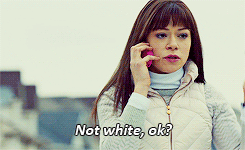 |
| Oh, Ali. () |
The idea of being controlled by an ideology is even more pertinent to clones Cosima and Helena. Both are very devoted to their way of seeing the world (through the lens of science or religion, respectively), and both are manipulated into doing unscrupulous deeds because of their ideologies. Helena, believing that she is the original and blessed by God, is led to murder her genetic identicals.
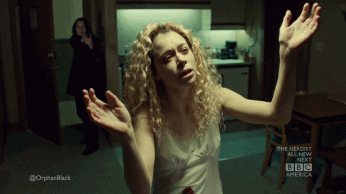 |
| () |
Cosima, lured by the possibilities of the DYAD Institute, and the trust of her attractive new scientist friend Delphine (who, unbeknownst to Cosima, is her monitor), is lulled into a sense of false security, allowing Delphine to access information that puts the other clones in danger. As a result, Orphan Black shows us that blindly following your ideology is dangerous indeed.
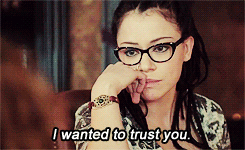 |
| () |
Postmodernism is distrustful of ideologies for this very reason: when perceiving the world through your own ideology, you cannot understand the world’s complexities. Orphan Black provides a cautionary tale of modern blindness.
ARCHETYPES WITH A TWIST
Now, a show like Orphan Black wouldn’t allow it to be as simple as each clone only exhibiting their one dimensional and stereotypical ideologies. Nope. In typical postmodern manner, ideology and identity are twisted, revealing our fractured selves.
As we have already seen, Cosima acts on her feelings for Delphine when she chooses to trust her, instead of following her supposed “smart” ideology of reason. Sarah is presented as a grifter con-artist, but her archetype is twisted the moment the show opens, when Sarah calls her foster mother hoping to speak to her daughter; Sarah is a caring mother to Kira, and foster sister to Felix, despite her rebellious tendencies. Even as Helena murders her clones, she is presented as childlike and confused. And we can’t forget suburban Alison who hosted the neighborhood potluck while torturing her suspected monitor husband with a glue gun.
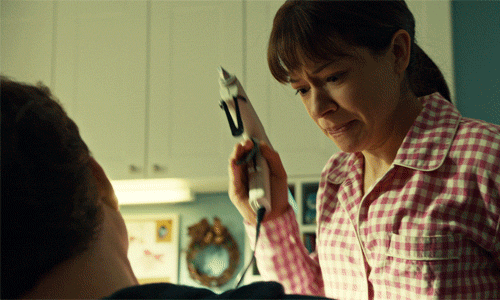 |
| () |
The fragmentation of identity is even present in the cinematography of Orphan Black. There is an almost constant presence of mirrors, reflecting each clone’s ideology back at them. The clones are also often distorted, representing the fragmentation and mixing of what it means to be each of them.
 |
| Just look at those reflections! () |
By twisting each clone’s stereotypical archetype, Orphan Black again calls into question the soundness of the ideological system. It challenges the idea of one-dimensional people by promoting the fragmentation of personality and action. It shows that there is more than one truth about who these people are.
"SHITE" GOING DOWN: THE CLONES' JOURNEY
The events that take place in Orphan Black are far from everyday life--and this helps Orphan Black to mirror the modern to postmodern journey of the Western world through the clone story. As the clones become self-aware, their viewpoint must shift from a sensible, business-as-usual, modern perspective to the convoluted life of a postmodernist. How can you view the world in a modern light, believing in your own individuality and steadfast opinions, when it all it would have taken was the swapping of two embryos thirty-ish years ago for you to have become a murderer? Or, for that matter, a soccer mom? Life as a clone is inherently fragmented and subjective. In a subjective world, how can their be an ultimate truth?
The increasingly postmodern aspects of the clones lives become more interesting when you consider the modernism of those who attempt to control them. For example, the whole premise of Neolution is very modern.
 |
| () |
“Self-directed evolution” in the hopes for a perfect human? Despite Delphine’s protests, Neolution is both eugenical and utopian. The search for a perfect human assumes that perfection can be attained, which is a very modern idea. The DYAD Institute, while on the cutting edge of technology, is bogged down in its historical ideology.
Similarly, the Proletheans are also lost in their ideology. In their relentless journey to kill and use the clones, they overlook one of the most important parts of Christianity: “thou shalt not kill.” The Proletheans' blindness to the contradictions of their ideology is also very modern, as modernism strives to eliminate contradictions such as these.
Unlike the clone’s ideologies, which are malleable, the ideologies of the DYAD and the Proletheans are not subject to change. Their unrelenting assurance that they are right--and that the other is wrong--gives them the leeway to commit moral outrages.
MONITORS: ESCAPING IDEOLOGY?
Is there hope to escape the blindness of a modern view of the world (without being a clone, of course)? It is the monitors we must look toward to answer this question. Of the monitors we have met so far (Paul, Delphine, and Donnie), each has a different way of straddling their relationship with corporate DYAD and the experiment that they monitor. They (much like the audience) are watching the clone drama unfold. Monitors are, therefore, in the unique position of being able to choose between following the DYAD Institute’s blind ideology, giving themselves over to the clones they have grown to care for, or finding their own path.
Especially interesting is the case of Delphine. From all of the evidence the show had presented, Delphine has fallen in love with Cosima.
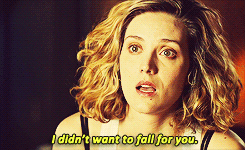 |
| () |
However, Delphine also choose to work for DYAD for its scientific prominence (not via blackmail, like Paul), including all of it’s shaky ethics. Delphine’s actions, however, have not placed her squarely on either side. In Season 1, Delphine chooses not to disclose the existence of Kira, Sarah’s daughter and the first biological child of a clone, thus showing her allegiance to the clones. However, when Cosima entrusts Delphine with her blood samples, Delphine hands them over to DYAD. Here, we see that Delphine has a mind of her own, weighing the possibility that DYAD could help to cure Cosima’s life threatening illness over Cosima’s wishes.
 |
| () |
When choosing her own way, Delphine must weigh the ideologies of both parties against her own. Postmodernism tells us that it is impossible to interpret the world through anyone’s point of view but your own. But Orphan Black shows us there is still hope to view the world in a more complex way. While we cannot escape ideology, we can monitor it--keeping in the back of our mind that the truth is subjective, the world a big and complicated place, and that is a very postmodern take on television.

Ariana is an internet enthusiast, nature lover, and environmental activist. When not (obsessively) analyzing TV shows, she attends high school in the US of A.
Follow Ariana on


No comments :
Post a Comment